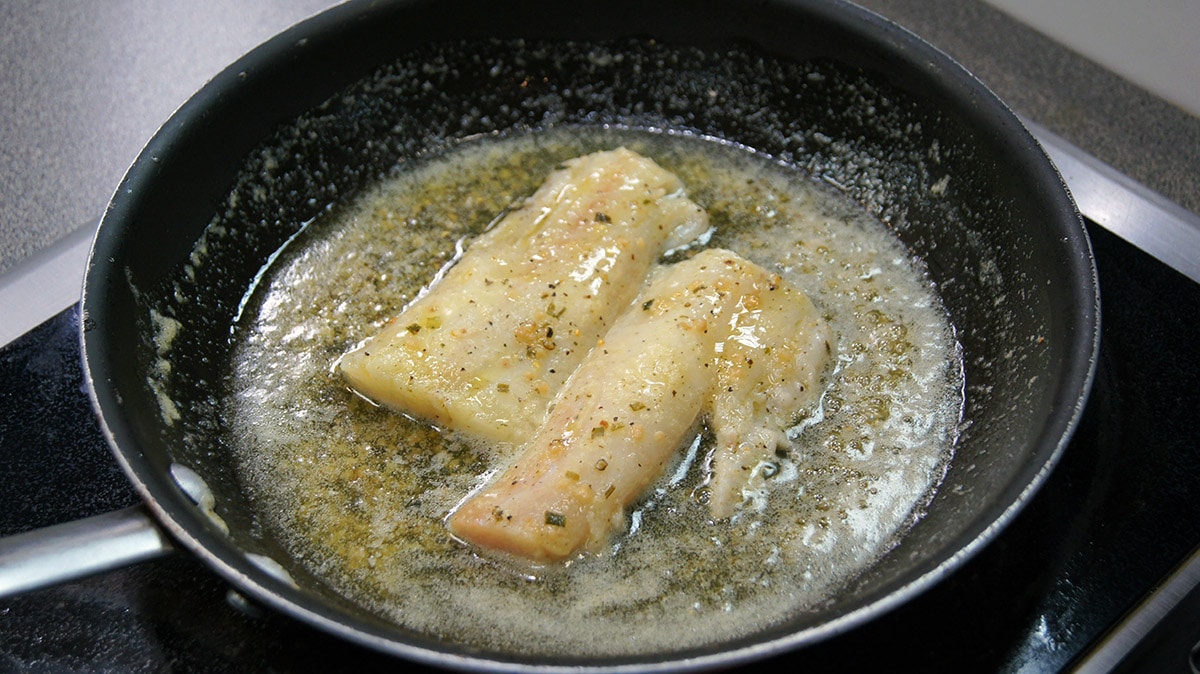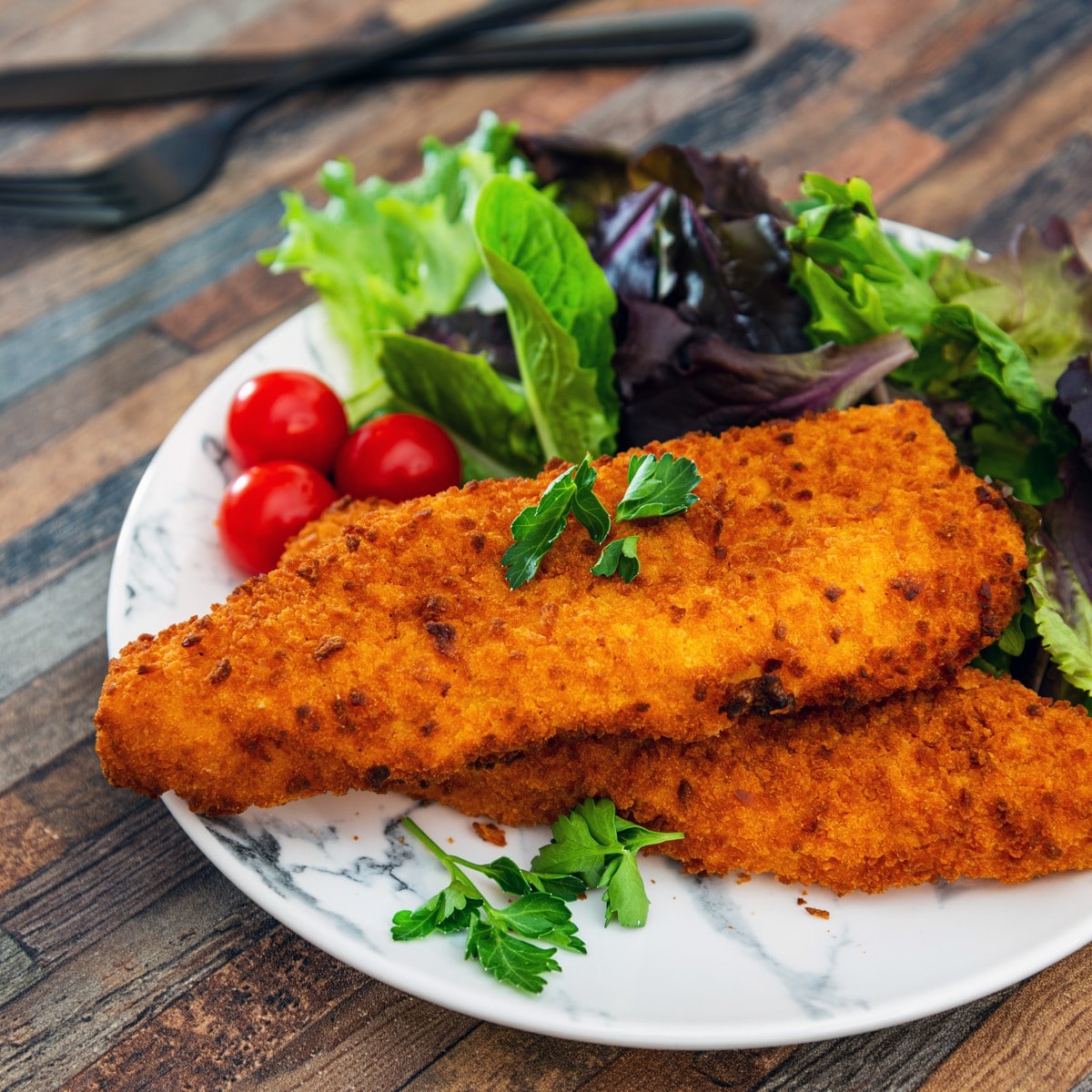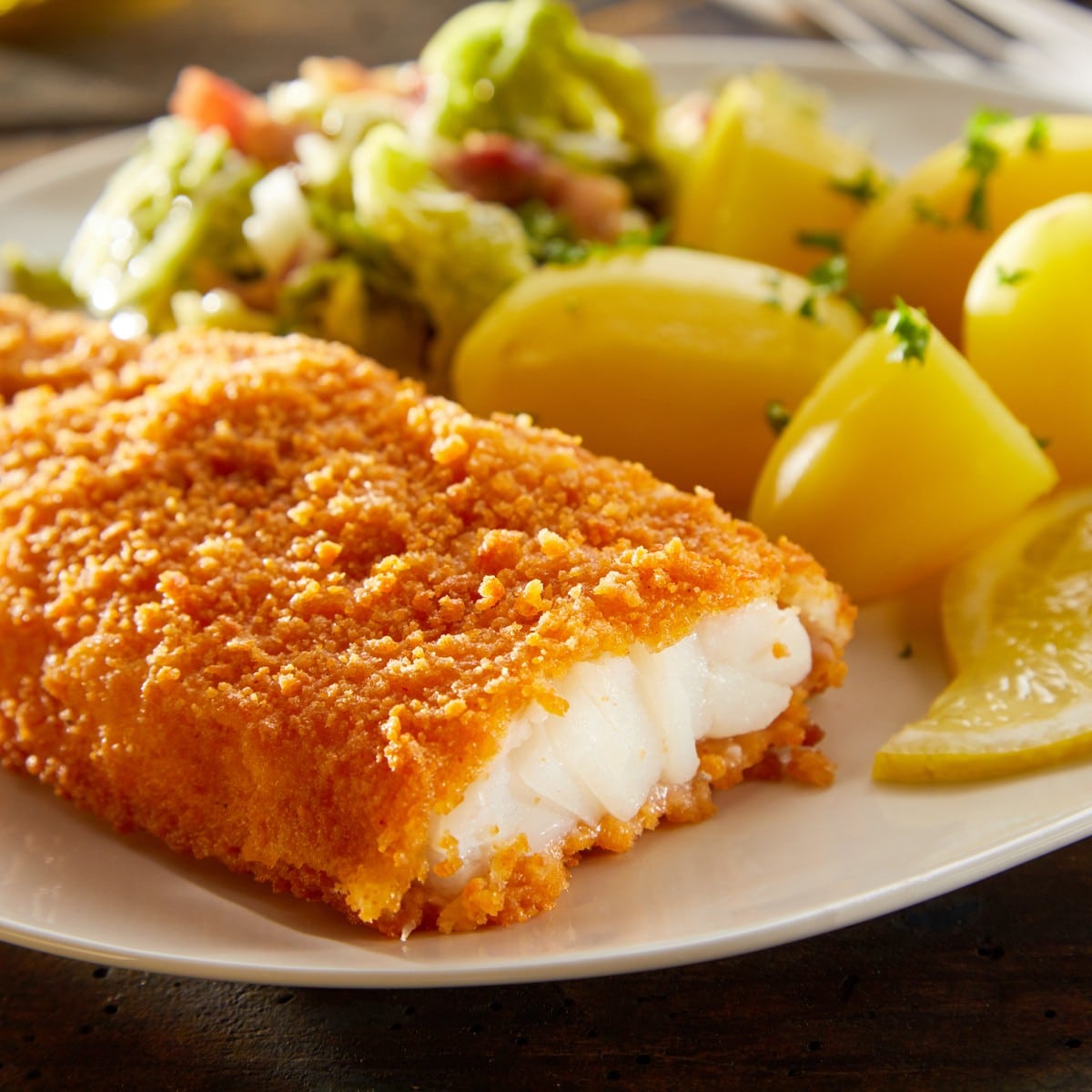
Introduction to Pollock
Pollock or Pollack (Pollaccius virens) belongs to the cod family and is a marine fish found in temperate, subarctic waters around the world. It is often mistaken for or used as a substitute for other fish living in the Atlantic, Pacific and Arctic Oceans, such as cod.
Pollack is an economically significant commercial and recreational fish responsibly managed by the International Council for the Exploration of the Sea (ICES) to ensure future populations.
This fish is an essential component of many traditional dishes, such as fish chowder, and is commonly smoked and dried for use in salads and soups.
Physical Characteristics
Pollock is recognisable by its light brown to silver sheen hue with side-to-side lateral line and numerous shallow black spots along its sides. The species has a sloping back, an extended tail, large eyes, and fleshy lips. Its digestive organs give the fish a distinct ‘peanut-shaped’ profile in the water.
When fully grown, pollock can range from 8 to 24 inches (20 to 62 cm) in length and weigh one to seven pounds (0.4 to 3.2 kg).
Habitat and Feeding
Pollock generally inhabits water depths of 30-350m and temperatures of 6-10C. Geographically, it lies in the region of the Pacific Ocean, heavily influenced by oceanographic currents.
Pollock primarily feeds on small fish and marine invertebrates, such as crustaceans. The type of prey they consume can vary seasonally, so they must move around to remain in areas where their food source is abundant.
Distribution of Pollock Stocks
Pollack is a family of marine fishes, including Alaska Pollock, Walleye Pollock, Pollachius virens, and Atlantic Pollock. Pollocks inhabit the North Pacific Ocean, ranging from Alaska and Oregon in the US, north to Japan, and south to the Bering Sea. This species lives also around the Aleutian Islands, the Korean Peninsula, the Bering Sea shelf, and the northern and eastern parts of the Sea of Okhotsk.
They primarily inhabit cold waters but can also be found in shallow bays and deeper waters. Pollocks congregate in large schools, usually associated with other fish species such as cod and herring. Pollock migrate in search of food, forming large schools and moving around to find the most suitable food sources.

Fisheries and Uses Fishing for pollock has a long history and occurs in fresh and saltwater environments. These fisheries fall into recreational and commercial. Most North Pacific pollock fisheries are certified sustainable by the Marine Stewardship Council (MSC). The fish is available all year round, especially in winter, when stocks are higher.
Population and Conservation
The US Regional Fishery Management Councils are responsible for the sustainable management of pollock throughout its range. To demonstrate responsible leadership, the Marine Stewardship Council has certified the pollock fishery in Alaska, the northeast Arctic, and the Ross Sea fishery.
In 2010, the International Fisheries Commission approved fishing limits in the Atlantic pollock fishery. Fisheries have focused on improving the sustainability of the species and ensuring sustainable management. Methods of capture include trawling, gillnetting and purse seining, although currently, some areas prohibit trawling. Gear and fishing techniques improved, reducing the bycatch of other species. Discards of pollock are very low, typically less than 1% of the total catch.
Stock assessments take place each year to ensure that the health and population size of pollocks remain healthy. Maximum sustainable yield (MSY) is a critical component of management, ensuring that enough pollock are left each year to reproduce and maintain successful reproduction of the species in the long run.
Regulations have also been implemented to promote pollock fisheries’ sustainability, including catch limitations, gear restrictions, closed seasons, size limits, and bycatch limits. The use of sorting grids and turtle excluders has successfully reduced bycatch.
Conservation Status
Various conservation efforts are in place to better preserve the pollock population. These include the International Commission for the Conservation of Atlantic Tunas (ICCAT) and the World Wildlife Fund (WWF), limiting the number of fish caught in a fishery and advocating for sustainable fishing methods.
The Sustainable Fisheries Partnership and the Marine Stewardship Council identify Pollock as a sustainably-managed species. The latter’s certification program provides evidence that the Pollock fisheries are managed responsibly with minimal environmental impact.
Other conservation efforts dedicated to the pollock population include:
- Research into their life history and biology.
- Identifying potential problems within the fishery.
- Advocating for strict fishery management practices.
Additionally, the formation of Marine Protected Areas (MPAs) and selective fishing gear aim to reduce fishing pressure on the species and allow it to recover.
Pollock’s Diet
Pollock feeds mainly on fish, crustaceans, molluscs, and plankton. They adapt their diets to their developmental stage, migrate to areas with plentiful food sources, and adjust depths to find optimal temperatures for foraging. As they reach adulthood, they become more of an ambush predator, preying on smaller, slower fish.
Reproduction
Life Cycle of Pollock
The main stages of a pollock’s life cycle are egg, larvae, juvenile and adult. Spawning usually occurs between April and September, with peak spawning in the Northern Hemisphere occurring in May to June and July to October in the Southern Hemisphere.
Pollock spawns typically in shallow coastal waters. The eggs have adhesive properties and will stick to the substrate lying on them, making protection from predators difficult. The pollock larvae are planktonic and remain in the open ocean until they are large enough to settle on the bottom. An adult pollock can lay up to one million eggs per spawning season, which hatch in two to three weeks.
Temperature and seasonality are significant factors that affect the pollock’s life cycle. As the season changes, so does its movement; they will move to deeper waters or areas of low temperatures. Young pollock are tiny individuals, around 4 cm (1.5 in) long, and grow steadily over 5-6 years until they reach sexual maturity.
Classification
Pollock (scientific name: Pollachius) is a group of fish in the Gadiformes family. Several names exist in different languages, such as colin (French), Gadus virens (Latin), peling (Norwegian), lascia (Italian), Morue touladi (French) and Schellfisch (German). In some parts of Canada, it is called either Hammers or Bulldogs.
Etymology
The term pollock derives from the Scottish Gaelic poll, which means cobbled fish. It is an old term for a particular hook used to catch pollock. The scientific genus name for Pollock is Pollachius, derived from the Greek word pollux, which means sailor or navigator; said to be an appropriate name for the fish due to its navigable swimming pattern.
Significance
Pollock is a commercially significant fish, harvested for its meat and omega-3 oils, widely used in the food and pharmaceutical industries. Recreational fisheries offer excellent opportunities for pollock, with many fishing methods employed to target them. Pollock has been an instrumental part of the history of fishing communities in the northern Atlantic for centuries and continues to play a significant role in local economies.
Uses
Due to its mild-tasting, flaky flesh, pollock appears in various dishes, including seafood chowder, fish tacos, stews, and fish and chips. It is also a popular choice for batters, smoked fish and sandwiches. Pollock can be cooked in many ways, including pan-frying, baking, grilling, broiling, and frying. Its flesh and oil are also refined and used in cosmetics, food additives and pet food products.
Popularity and Availability
Pollock is one of the most consumed seafood items in the United States and is widely available in fresh, frozen and canned forms. Its health benefits have recently been acknowledged, with research showing that it is a lean, high-protein source of essential vitamins and minerals. As wild-caught seafood, it is a sustainable and great-tasting option for those looking for an alternative to farmed fish.

Nutritional Values
Pollock is a rich source of essential nutrients, such as selenium, iron, phosphorus, and zinc, as well as vitamins D and B12. Its primary benefit is its great Omega-3 fatty acid content, which is higher than most other fish.
Omega-3 fatty acids can help reduce inflammation and lower cholesterol, reducing the risk of severe health conditions such as heart disease, stroke, and asthma. Studies have also shown that the selenium in pollock can help lower the risk of certain types of cancer.
Pollock’s high-protein content helps to aid digestion, while its low fat and calorie profiles make it an excellent source of lean protein. It is also high in vitamin D, essential for strengthening bones and teeth.
Versatility
Pollock is a sustainable fish not subject to overfishing, making it an excellent choice for environmentally conscious households. The fish are prepared in various ways due to their firm texture; they can be roasted, grilled, or cooked quickly due to their high moisture content.
Pollock’s mild flavour stands out when paired with simple seasonings or sauces. It can also be eaten raw or cooked, depending on the individual’s preference. When compared to cod, pollock is smaller and has a lighter flavour. It is lower in fat and calories and better suited to crisp recipes due to its firm texture.
Taste and Texture
Pollock is often compared to cod and haddock for its mild flavour and delicate texture, though it is slightly more savoury. Pollock’s subtle taste allows the flavours of other ingredients or seasonings to be the main focus.
The flavour is further enhanced when cooked in simple yet creative ways, adding a splash of lemon juice, a pinch of salt, and some herbs. Pollock stands out due to its unique qualities – it can be lightly fried, grilled, poached, or baked but is also popular when pickled, smoked or salted, giving it a more robust flavour.
Cooking Pollock
Pollock (also known as Alaskan Pollock, Nushagak, Walleye Pollock, or Theragra chalcogramma) is a North Pacific marine fish with a mild flavour and firm texture. It is one of the world’s most widely consumed and frequently caught fish, especially in the United States. Pollock is an excellent source of lean protein that provides numerous essential nutrients and minerals.
Pollock is a versatile ingredient that may be prepared in various ways. These methods range from baking, grilling, pan-frying, deep-frying, and poaching.
Preparation
Pollock is versatile and can be prepared to suit many different dishes, depending on the desired result. It is usually obtained through wild capture through commercial fishing, although farming of this specie occurs in Russia and China. It is commonly cooked by roasting, baking, deep-frying, or boiling, and popular dishes include fish and chips, tempura, and sushi. For example, it can be eaten grilled, fried, baked, steamed, poached or smoked.
In some countries, it is used as a substitute for cod or haddock, while pollock roe is pickled or consumed with condiments (like soy sauce) in some cultures. In addition to culinary use, Surimi (a processed seafood product resembling crab meat) often comes from pollock.
- Baking – The optimal way to cook pollock, as it requires little oil and still yields flavorful results. To bake, place the pollock fillet on a baking sheet and season it with your desired spices. Bake in the oven at 400 degrees Fahrenheit for about 15 minutes until the fish is flaky.
- Grilling and Pan-Frying – These are both delicious methods for cooking Pollock, yielding a flaky and flavorful fish. To grill Pollock, brush with oil or marinade, wrap in tin foil, and place it on the grill for 10 minutes. To pan-fry, heat oil in a skillet and carefully place the fillet in the pan. Cook for about 5 minutes per side.
- Deep-Frying – Deep-frying is optimal if you’re looking to make a fried fish dish. For this method, coat the Pollock fillets with batter and carefully place them into hot oil in a deep frying pan. Cook until the crust is golden brown.
- Poaching – an excellent if you are looking for a more delicate-flavoured fish. To poach, place the fillets in a skillet of simmering fish stock or water for 10 minutes.
Best Side Dishes for Pollock
When cooking with Pollock, it is advisable to use light ingredients and flavours that don’t overpower the delicious, delicate, and flaky fish. Popular side dish options for Pollock include roasted and grilled vegetables, creamy soups and salads, noodles and pasta with simple sauces, and herbed butter. Mashed potatoes, couscous, quinoa, risotto, lemon-coconut couscous, orange-ginger spinach, and mango-cucumber salsa are all suitable choices.
Crispy onions and garlic can add a crunchy texture. Nuts like almonds and walnuts will bring a nutty flavour. A contrast arises between these ingredients and the mild taste of pollock. Creamy or cheesy dishes such as mashed potatoes, pasta, risotto, and polenta can be served with the pollock to provide a creamy texture and flavour.
Fresh vegetables and fruits like bell peppers, sweet potatoes, Brussels sprouts, carrots, eggplants, oranges, apples, and pears also pair well with pollock dishes. For freshness and flavour, herbs like parsley, cilantro, basil, and dill are excellent additions. Creative recipe ideas for pollock include serving it en papillote (in parchment paper pouches), tacos, sandwiches, and tartines. Traditional sides such as mashed potatoes, fries, and coleslaw can also be served alongside, as well as more adventurous sides like lemon-coconut couscous, orange-ginger spinach, and mango-cucumber salsa.
Overall, when cooking with pollock, use light flavours and ingredients to let the delicate flavour of the fish shine through. You can create a delicious, healthy, and flavorful meal with suitable side dishes and accompaniments.
Suitable Spices
In addition to light flavours, pollock pairs well with various herbs, spices, and aromatics. These include garlic, wine, lemon, dill, parsley, capers, anchovies, chives, cilantro, thyme, oregano, onion, bacon, capers, and mustard. Citrus fruits like lemon and lime add a bright and acidic note. Alternatively, spices like cumin, paprika, turmeric, garlic powder, chilli powder, and black pepper will provide depth and flavour.
Popular Recipes
Popular recipes for pollock include fish tacos, cakes, stews, chowders, and a classic beer-battered fish & chips dish.
The French “Brandade de Morue”, a traditional dish combining salt cod, potatoes, garlic, cream, and olive oil, is also popular. Fish and chips is a favourite dish featuring pollock in Europe and Canada.
Traditional Dishes
Scandinavian dishes include pollock, such as gravlax. Japanese cuisine also uses Pollock, typically featuring the fish in sushi, but Pollock can also be boiled, steamed, and grilled for various recipes. In Korea, Pollock is often dried and used as a stock for Korean Court Bouillon, a hot-and-sour stew. Chinese cuisine often uses Pollock in dishes, such as Sweet and Sour Pollock, Mapo Pollock, and Honey-Deep Fried Pollock. Russian recipes utilising Pollock include Caviar and smoked Pollock, mainly used as an ingredient in soups and salads. Additionally, Pollock’s mild flavour lends itself to dishes such as Italian Calamari al Figo, made with Pollock, tomatoes, white wine, garlic, and herbs.
Fish like pollock are mild, sustainable, and highly versatile, rendering them a staple in many cuisines across the globe, sold in most supermarkets. Its mild taste makes it an ideal choice for a wide range of dishes, while its sustainability and affordability make it an attractive option for chefs and seafood enthusiasts.
Cultural and Culinary Similarities/ Cultural uses
It is sought after by recreational anglers and consumed as a delicacy in some cultures. Moreover, it is a crucial ingredient in surimi production, a processed seafood product popular in Japan, Korea and other parts of Asia.
Conclusion
Pollock is a highly versatile fish that can be cooked in many different ways. Baking, grilling, pan-frying, deep-frying and poaching make for flavorful and delicious options. Pollock is an excellent source of lean protein that provides numerous essential nutrients and minerals.
It is an economical, nutritious, sustainable seafood option with a mild flavour and delicate texture. With its unique qualities, pollock is a popular choice among consumers worldwide. Choose the desired cooking method and follow the instructions for a tasty and nutritious meal.
